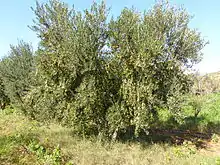Koroneiki
The Koroneiki is an olive cultivar from Greece primarily used in olive oil production. After the Arbequina and Arbosana, Koroneiki olives are among the most common and suitable for high density growing systems around the world.[1][2] The most common variety for oil production, Koroneiki olives cover 50-60% of the acreage in Greece.[3] Koroneiki fruits are small, but have a high quality oil yield.[4]
| Koroneiki | |
|---|---|
 Koroneiki olives in Ghar El Melh, Tunisia | |
| Olive (Olea europaea) | |
| Origin | Greece |
| Use | Oil |
Synonyms
Koroneiki is grown in Greece and also called Koroni in Kefallinía, Kríti, Pelopónnisos, Sámos, and Zante. Kritikia in Icaria, Kríti, some areas of Pelopónnisos, Sámos, and some areas of Zante. Ladolia in some areas of Kríti, Messini, Milos, Pátrai, and in some areas of Pelopónnisos, Sámos, and Zante. Lianolia in some areas of Kríti. Psilolia in some areas of Messíni, Mílos, Pátrai, and Pelopónnisos. Vaciki in some areas of Pelopónnisos, and Coroneiki in areas of Corsica, and Tunis.[5]
Cultivation areas
Koroneiki is grown in Greece, Albania, Australia, Brazil, Chile, China, Cyprus, Egypt, France, Israel, Italy, Mexico, New Zealand, Portugal, Saudi Arabia, Spain, Tunisia, United States, and Uruguay.[6]
References
- World Olive Encyclopedia, International Olive Council, 1996, p. 149, ISBN 8401618819
- Super-High-Density Olive Production in California (PDF), UC Davis Olive Center, November 2009, archived from the original (PDF) on 2015-03-05, retrieved 2015-03-09
- World Catalogue of Olive Varieties, International Olive Council, 2000, p. 95, ISBN 978-84-931663-1-1
- Paul M. Vossen (2007), Organic Olive Production Manual, UCANR Publications, pp. 9, 32, ISBN 978-1-60107-440-9
- Koroneiki synonyms- Retrieved 2018-07-08
- World production areas- Retrieved 2017-07-08
